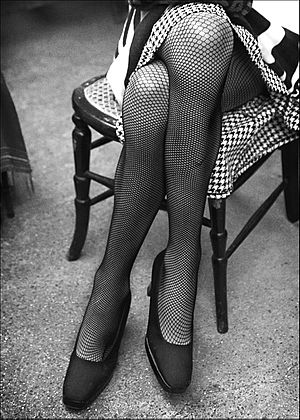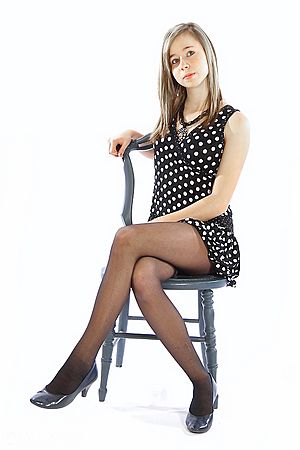Pantyhose facts for kids
Pantyhose, also known as sheer tights in the United Kingdom, are a type of clothing that covers your legs and feet from your waist to your toes. They fit closely to your body. Most often, women and girls wear pantyhose. They first became available in stores in 1959. A product called 'Panti-Legs' by Allen Gant was one of the first. Pantyhose offered a handy choice instead of wearing stockings.
Pantyhose are usually made from nylon or a mix of nylon with other fibers. They are made to:
- Look nice and smooth on your legs.
- Help hide things like small marks, bruises, or spider veins on your legs.
- Make sure that lines from underwear don't show through clothes.
- Stop your feet from rubbing inside your footwear or your thighs from rubbing together.
Besides being a fashion item, pantyhose are sometimes worn by women for formal dress in Western countries. Some companies and schools also have rules that say you must wear pantyhose or fashion tights with skirts or shorts as part of a uniform.
Contents
What Are Pantyhose Called?
The word "pantyhose" started in the United States. In the United Kingdom, these items are called "sheer tights". The word "tights" by itself in the UK can mean any similar garment, whether they are thin and see-through or thick and strong.
In American English, "tights" usually means clothing like pantyhose but made from thicker material. These are often solid-colored or only a little see-through. Thick legwear made of material like spandex is often worn by both boys and girls for sports or as everyday clothes. These are usually called "leggings". Leggings can be worn as outer clothing, while tights are usually worn as an undergarment or part of an outfit. Leggings often have a seam on the inside of the leg and usually don't cover the feet, unlike tights.
How Pantyhose Began

The story of pantyhose is linked to how women's dress styles changed over time. Before the 1920s, women usually covered their legs, including their ankles, when they were out in public. Dresses and skirts were usually long, reaching the ground. The main times tights were worn were for sports or entertainment.
In the 1920s, fashionable skirts started to get shorter, showing the legs just below the knees. Stockings became popular to keep legs covered and warm. The most popular stockings were thin and see-through. They were first made of silk or rayon. After 1940, they were made of nylon, a new material invented by DuPont in 1938. In the 1940s and 1950s, people who made stage shows and movies would sew stockings to the shorts of their actresses and dancers. This made a single garment, like what we now call pantyhose.
In 1953, Allen Gant Sr. of Glen Raven Knitting Mills created a product similar to these sewn-together hose. He called them "Panti-Legs," but they weren't sold to the public until around 1959. Around the same time, Ernest G. Rice also designed pantyhose. In 1956, he got a patent for his "Combination Stockings and Panty." Other companies started using his design, which led to legal arguments for many years.
In 1974, actress Julie Newmar got a patent for her own pantyhose design. It had a special band to shape the rear. She made this design famous with the costume she created for her role as Catwoman in the 1960s TV show Batman.
Before the 1960s, most women didn't need pantyhose because longer skirts allowed them to wear stockings held up with a garter belt. However, in the 1960s, new ways of making textiles made pantyhose cheaper. Also, human-made materials like spandex made them more comfortable and strong. The popular miniskirt, which showed legs far above the knee, made pantyhose a must-have for many women.
In 1970, more pantyhose were sold in the U.S. than stockings for the first time. Pantyhose became a common item in wardrobes throughout the 1970s and 1980s.
After 1995, sales of traditional pantyhose started to go down. By 2006, U.S. sales were less than half of what they used to be. This happened because bare legs became fashionable, workplace dress codes changed, and trousers became more popular.
Even though sales of classic styles dropped, other types of legwear became popular in the 2000s. These included Fishnet hose, patterned and colored tights, opaque (not see-through) tights, and low-rise pantyhose. In the 2010s, tight-fitting opaque leggings became very popular for casual wear and even some office outfits. While leggings took over some of the fashion roles, pantyhose are still popular for formal wear.
Things to Think About
There are a few things to consider about pantyhose:
- Unlike cotton, nylon doesn't soak up sweat well. This means sweat can stay on your feet and legs, which might lead to bacteria and odor. Some products now have silver to help prevent odor and sweating. Wearing silk stockings can also help reduce sweat.
- Some people choose not to wear nylon pantyhose because of environmental concerns. Nylon pantyhose usually cannot be recycled and do not break down naturally. This means they often end up in landfills. Burning nylon can also release harmful chemicals into the air.
However, in the UK, some local recycling centers and curbside collections now accept clean, dry textiles, including tights and pantyhose. These items can be recycled and turned into new things like roofing felt. There are also many ideas online for reusing old pantyhose, even if they have a "run" (a tear). In the US, nylon stockings and pantyhose can be sent to places that use them for craft projects, like pet toys or rugs. Some companies, like Swedish Stockings, even have programs to grind down old pantyhose to use in other products.
Related pages
Images for kids
See also
 In Spanish: Pantimedias para niños
In Spanish: Pantimedias para niños




